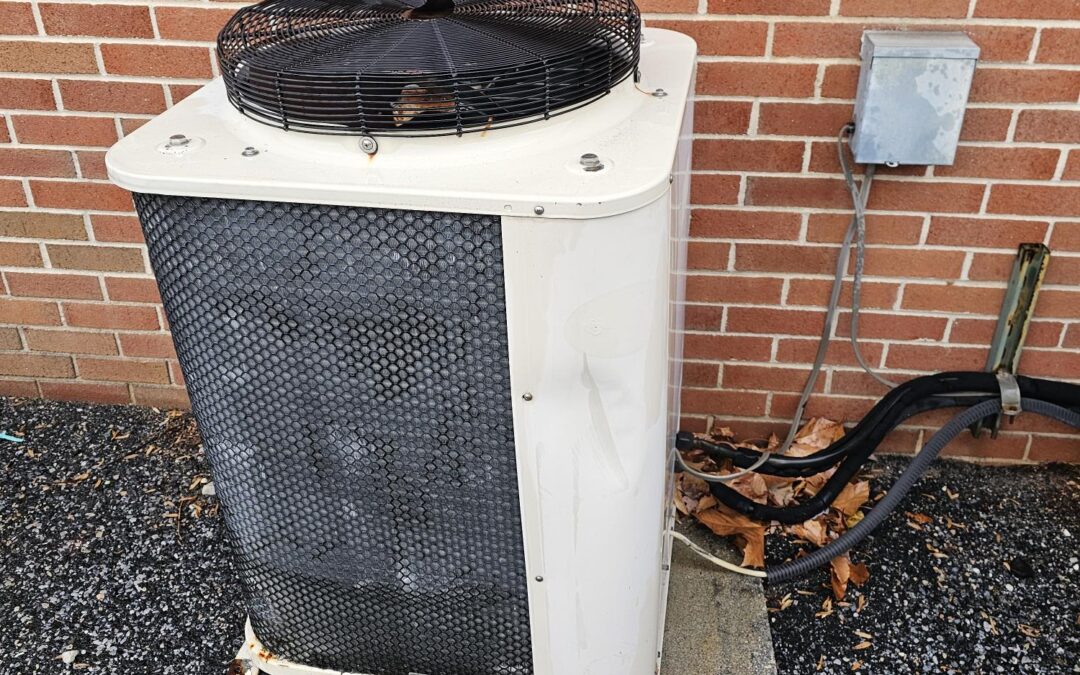Cause of Death – Suffocation
Outdoor Unit Airflow Issues
The primary cause of inadequate airflow around the outdoor or condensing unit is dirt accumulation on the coil. This dirt can become trapped deep within the coil, often making it difficult to see. To inspect properly, shine a flashlight through the opposite side of the coil. It should shine through bright! If airflow is blocked, heat transfer efficiency decreases, causing the compressor to work harder. As a result:
- Energy consumption rises (Higher Electricity Bills) due to increased refrigerant pressure in the outdoor coil.
- The compressor motor temperature spikes, leading to faster deterioration of its windings and breakdown of the lubricant.
- The lifespan of the compressor is significantly reduced.
Additional causes of poor airflow include:
- A malfunctioning or improperly operating outdoor fan motor.
- Objects placed too close to the condensing unit, restricting airflow.
- The unit has been improperly installed too close to a wall.
To prevent these issues, the unit should be located properly. The condenser coil should be thoroughly cleaned annually using high-pressure water, taking care not to bend the fins. If fins become bent, they should be straightened by a technician.
Indoor Airflow Issues
One of the most common causes of poor airflow in the indoor unit is an undersized or poorly designed duct system. It is crucial to address and correct this problem, both for the longevity of the system, and the level of comfort in the home. Until the system is evaluated and fixed, you are greatly increasing the wear and tear of the system. (Think of towing an RV trailer with a Prius.)
Another major cause of inadequate airflow is an oversized heat pump/air conditioning system. For example:
- A home originally designed for a 3-ton heat pump is upgraded to a 4-ton system without modifying the ductwork. (Please see my related article titled ‘Bigger isn’t Better.)
- The old duct system, already marginal at handling 1200 cubic feet per minute (CFM) of airflow, now needs to accommodate 1600 CFM.
- The mismatch causes excessive strain on the compressor and indoor unit from day one.
We, or any properly trained and qualified technician can diagnose this issue by analyzing the distribution and measuring temperature, pressure, and air velocity. If the duct system cannot handle the increased airflow, average technicians may attempt to increase the indoor fan speed. However, this often leads to huffing, where the fan cycles between high and low speeds due to excessive air pressure build up in the ductwork. This condition, if efficiency, longevity and comfort are to be maintained, must be corrected by proper analysis and modification of the duct system. (PLEASE NOTE: A wise instructor once taught me that “About 90% of ALL air-flow issues can be corrected within 4 feet of the unit”. That was over 20 years ago, and I have found it to be damn accurate, very useful in helping my customers, as well as way more affordable than expected!)
Other airflow restrictions include:
- Dirty air filters, indoor coils, or blower fans – Filters should be replaced regularly and indoor coils and blower fans should be inspected and cleaned at least every two years.
- Closed dampers or blocked registers – Closing too many vents disrupts airflow, leading to improper operation and compressor damage.
- Overcharging refrigerant
All of the above can cause the ‘magic’ that is “air conditioning (or heat pumps) to not work properly, creating a situation we call “Slugging The Compressor”.
The Impact of Slugging on Compressors
One of the most severe consequences of insufficient airflow is slugging, where liquid refrigerant flows back into the compressor instead of gas. This issue is a leading cause of compressor failure. Studies from major manufacturers, including Copeland, show that over 95% of returned compressors fail due to slugging, not due to manufacturing defects. In fact, 80% of compressor failures result from improper installation—typically due to improper installation techniques (short-cuts), equipment oversizing, or ductwork design flaws.
How Manufacturers Diagnose Compressor Failures
To determine why a compressor failed, manufacturers perform a compressor autopsy, cutting open failed units to examine internal damage. Common signs of slugging include damage to:
- Valves
- Piston walls
- Crankshaft
My experience has reinforced this reality: compressor failures are rarely due to defective materials or workmanship within the compressor. Instead, they almost always result from either a poorly designed air distribution system, bad maintenance practices, or simple neglect.
Preventing Compressor Failures
To avoid becoming part of the widespread issue of improperly installed HVAC systems, homeowners must become ‘informed’ consumers. Many installation errors stem from ignorance or lack of training rather than intentional malpractice. In fact, I have found that a very large majority of contractors have never read the manufacturer’s installation instructions until they encounter system problems.
By ensuring proper installation and maintenance, you extend the life of your compressor and optimize your HVAC system’s efficiency. Whether installing a new system or servicing an existing one, following the correct guidelines is essential to prevent premature failures and costly repairs.
If you believe your home is suffering from any of the issues mentioned above, you can reach out to AllClimate, and we will have our Indoor Climate Specialist visit your home for a free analysis and recommendations for improvement.
‘Like to know how your air conditioner works? Watch this: https://www.youtube.com/watch?v=nVo0GuNm3Ek
CW2/25

